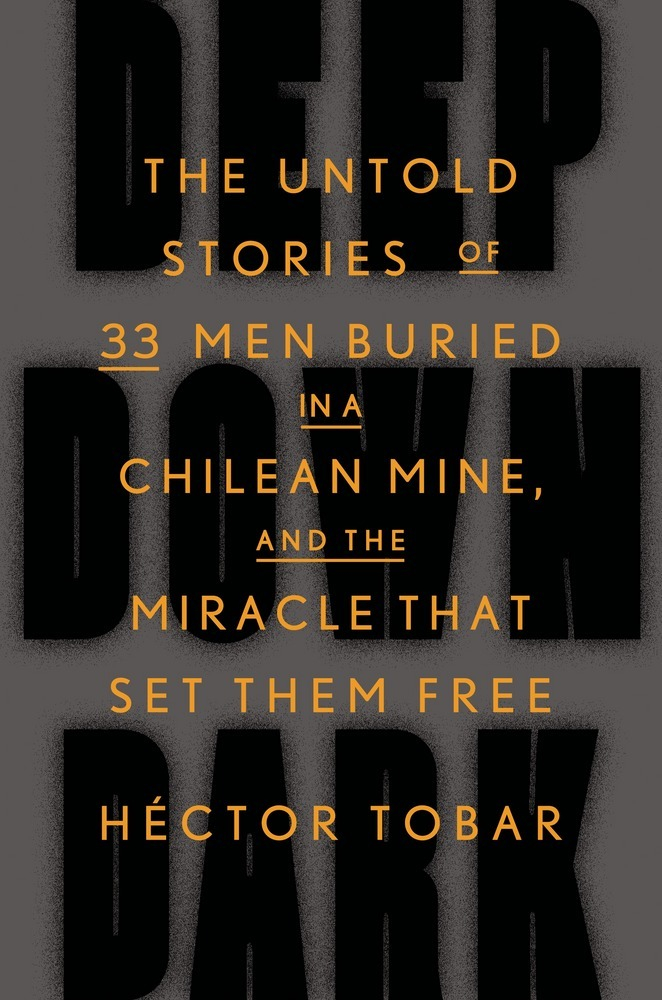Review: ‘We Are All Equals Now’: How Trapped Chilean Miners Survived

Deep Down Dark: The Untold Stories of 33 Men Buried in a Chilean Mine, and the Miracle that Set Them Free, by Héctor Tobar. Farrar, Straus and Giroux, 2014.
Imagine for a moment that you’re trapped at the bottom of a mine, 2,000 feet belowground.
It is dark, dirty, wet. The temperature is 85 degrees. You have very little food, and the water is tinged with oil. You don’t know who is trying to rescue you, how long it might take them—or even whether a rescue is feasible. The rumblings of rock breaking within the mountain are constant reminders that death may not be far away.
Imagine you share this predicament with 32 of your co-workers. How would you respond? How would they?
The miners of the San José gold mine in Chile, “Los 33,” found themselves in just this situation after their mine collapsed on August 5, 2010.
Their fascinating story is told in full for the first time in the new book Deep Down Dark. Author Héctor Tobar was granted exclusive access to interview the miners—because, even while they were still trapped, they had made a pact to share their story only collectively.
DEEP DOWN DARK
Los 33 came from all over Chile (and one was a Bolivian immigrant). Some were in their sixties and some were in their twenties. One was working his first shift underground.
As the story unfolds, we get to know them as unique individuals—with their own personalities, their own concerns, and their own loved ones on the surface. They haven’t always worked together; while some are friends, there are plenty of personality conflicts too. The miners have been on edge for weeks, because of the unusual cracking noises they’ve been hearing.
Working in the lower reaches of the mine, they experience the collapse as a loud explosion, followed by a cloud of choking dust. They try to reach the surface two miles away, using their only access tunnel, but they find it blocked by a wall of fresh granite.
As they gather to decide what to do, the foreman announces, “I am removing my white hat—we are all equals now.”
They settle down to wait, not knowing for what. Tiny communal meals, consisting mainly of a few shared cookies from their refuge chamber, become major events. It’s 21 days before the first drill breaks through, and another month and a half until there’s a hole large enough to bring the miners out.

SUPPORT LABOR NOTES
BECOME A MONTHLY DONOR
Give $10 a month or more and get our "Fight the Boss, Build the Union" T-shirt.
We get to know many of the miners’ families, friends, and loved ones as well. The book smoothly switches the scene back and forth between the underground and Camp Esperanza (Hope) on the surface, where hundreds gathered and waited.
Also on the surface were the drillers, the rescuers, powerful politicians, and an entire media circus. Once contact was established, the miners learned they were celebrities—heroes, even.
The prospects of fame and wealth bred jealousies. “During the 20 days we were starving and in despair, we were always united,” one miner remembered, “but once the food started to arrive and things got better, the claws came out.” In the end, though, they came through with their unity largely intact.
BUT WHY?
The book does not fully explore one key question—how did the miners come to be trapped in the first place?
Every miner knows that there must always be two ways out of a mine, and Chilean mining law requires it. In fact, the miners union (which represented only a minority of the miners at San José, and is never mentioned in the book) actually sued in 2004 to close the mine because there was no real second way out.
The mine was closed briefly in 2007, after a rock fall killed a miner. But even though promised safety improvements never materialized, the toothless regulatory agency allowed it to reopen. Safety conditions at San José were so notorious that wages there were 20 percent higher than at surrounding mines.
In fact, on the morning of the collapse, several of the workers expressed their concerns about the unusual thundering noises to the shift foreman. Some even insisted that they should evacuate the mine. But no one confronted the mine superintendent.
Perhaps the world would not have this great story if Los 33 had had a stronger union.
And it is a great story. A major Hollywood movie is due to be released this year—another result of the pact the miners made. I for one can’t wait to see it!
Christopher Mark was formerly an underground coal miner and member of United Mine Workers of America Local 781.





